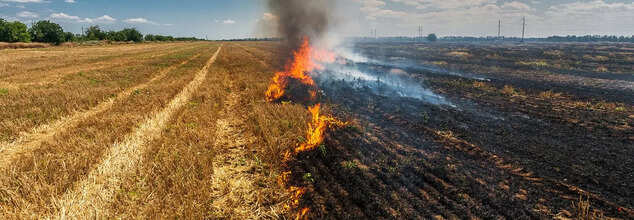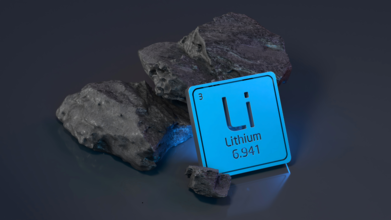- Health Conditions A-Z
- Health & Wellness
- Nutrition
- Fitness
- Health News
- Ayurveda
- Videos
- Medicine A-Z
- Parenting
- Web Stories
Smoke From Parali Burning Has Lethal Gases: Here's How You Can Protect Yourself

Parali Burning (Credit: Canva)
Parali burning—also known as stubble burning—is a practice that involves setting fire to leftover crop material after harvesting grains. Usually done in states of Punjab and Haryana, it is perceived as a magic bullet for farmers looking for a quick way to clear their farms. However, it is prime contributor to air pollution as it releases toxic gasses like carbon monoxide which facilitates air pollution. This can cause serious health issues like skin irritation, respiratory issues and severe diseases like cancer and asthma.
Ill Effects Of Parali On Health
Dr Sandeep Nayar, chest and respiratory diseases expert at BKL-Max Super Specialty Hospital, underscored that parali burning significantly contributes to air pollution, releasing a number of harmful pollutants which includes particulate matter PM2.5, carbon monoxide, nitrogen oxides, as well as volatile organic compounds (VOCs). He added that prolonged exposure to such kinds of pollutants can cause or worsen a number of respiratory conditions like asthma, bronchitis, or COPD."Pollution caused by stubble burning causes a severe threat to human health, particularly in regions where extensive stubble burning takes place as well as the neighbouring states where the poisonous polluted air flows into," Dr Nayar said.
Delhi's AQI Dips, Here's How You Can Take Care Of Your Health
Smoke from stubble burning, combined with other pollutants like vehicle smoke, dust etc are extremely dangerous to your respiratory system. You can follow these tips to protect yourself and your loved ones from air pollution.1. You can naturally cleanse your nasal passage and lungs by taking a steam, practicing control coughing, drinking green tea, consuming anti-inflammatory food items, and by consuming honey. You can also try Yoga to improve your breathing and cleanse your lungs.
2. Continue to check AQI forecasts near your area and keep a note of it to know when to avoid going out. Unless it is absolutely necessary, only then step out.
3. For your skin, cleansing, moisturising, and protecting it with sunscreen. You must include antioxidants in your diet and may consider detoxifying treatments.
4. To protect your eyes, wear sunglasses, use lubricating eye drops, stay indoors and keep the windows closed, practice eye hygiene and invest in an air purifier.
5. If you must step out, choose the afternoon time, as it is when the pollution is at its lowest. Dr Vivek Nangia, a Gurugram-based pulmonologist and a member of DocTube says that pollution levels tend to be slightly lower in the afternoon, however, it is vital to wear well-fitted masks.
6. Choose the correct mask, experts suggest that we go with N99 and N100 masks, which provide higher filtration. They are more efficient than N95 masks. Dr Sandeep Nayar, Principal Director and HOD, Chest & Respiratory Diseases at BLK-Max Super Speciality Hospital explains that preferably N95 should be considered as normal surgical masks do not prevent you from getting exposed to smaller pollutants including PM2.5 particles which may directly enter your airways and may diffuse into the blood and affect all organs of body.
Experts Shift Focus On COPD Patients
Meanwhile, many have expressed concerns about safeguarding the health of those suffering from Chronic Obstructive Pulmonary Disease (COPD). Air pollution, besides smoking, is the major cause of this serious health condition that is primarily characterized by difficulty in breathing. A person suffering from COPD experiences frequent coughing, wheezing, shortness of breath, fatigue, and frequent respiratory infections.Can THIS Naturally Occurring Element Treat Alzheimer's

Credits: Canva
A new study published this week in Nature has found that the loss of lithium, which is a naturally occurring element in the brain. This could be an early warning sign of Alzheimer’s disease and a key driver of its progression. Alzheimer’s affects more than 7 million Americans, and this finding offers fresh hope for treatment strategies.
The research, led by Bruce A. Yankner, a professor of genetics and neurology at Harvard Medical School, shows that lithium plays a vital role in maintaining the health of all major brain cell types in mice. When lithium levels in the brain drop, it appears to contribute to nearly all the major forms of brain deterioration seen in Alzheimer’s disease.
While lithium’s link to Alzheimer’s is new, the metal itself has a long medical history, most notably in mental health treatments.
What Is Lithium?
Lithium is the lightest metal found in nature. Silvery and soft, it’s best known today for powering our smartphones, laptops, and electric vehicles, all thanks to its ability to store large amounts of energy and discharge electrons quickly.
Its use in everyday products has an unusual history.
The original version of the soft drink 7Up contained lithium citrate and was marketed as “Bib-Label Lithiated Lemon-Lime Soda,” reported the Washington Post.
Lithium was removed in 1948 after the U.S. Food and Drug Administration (FDA) banned its inclusion in soft drinks.
Today, Australia leads the world in lithium production, while Bolivia, Chile, and Argentina form the so-called “lithium triangle” due to their rich reserves.
Lithium’s Role in Mental Health
Lithium carbonate, a chemical form of the metal, has been a cornerstone in the treatment of bipolar disorder since its approval by the FDA in 1970. It is considered a mood stabilizer and is sometimes prescribed for long-term depression management.
Although researchers still don’t fully understand how it works, lithium is thought to reduce stress in the brain and boost neuroplasticity, the brain’s ability to adapt and reorganize itself over time.
The new Nature study adds to this understanding, showing that our brains naturally contain small amounts of lithium.
Historically, lithium use in psychiatry dates back to the mid-19th century, but it gained prominence in the late 1940s when Australian psychiatrist John Cade found it helped stabilize bipolar patients.
“It’s been around for decades, and we have a lot of research and evidence supporting its use,” said Elizabeth Hoge to the Post. Hoge is a psychiatry professor at Georgetown University School of Medicine. However, Hoge cautioned that lithium treatment requires regular monitoring of kidney and thyroid function.
ALSO READ: Could Lithium Deficiency In The Brain Trigger Alzheimer’s?
Balwinder Singh, a psychiatry professor at the Mayo Clinic, as reported by the Post, calls lithium the “gold standard” for bipolar disorder, though it is prescribed less often in the U.S. than in Europe. Only about 10–15% of American bipolar patients take lithium, compared with around 35% in Europe. Singh also highlighted its unique benefit: “Lithium is the only mood stabilizer consistently shown to reduce suicidality.”
That said, some research has questioned lithium’s effectiveness for bipolar depression, finding it may not outperform placebos or antidepressants in certain cases.
Why Researchers Are Exploring Lithium for Alzheimer’s
Lithium’s potential role in Alzheimer’s is not entirely new. Past studies have hinted at its protective effects on the brain.
A 2017 Danish study suggested that communities with higher lithium levels in drinking water had lower rates of dementia.
Yankner’s team became interested in lithium after measuring the levels of 30 different metals in the brains and blood of three groups: cognitively healthy individuals, those in the early stages of dementia, and those with advanced Alzheimer’s. Of all the metals tested, only lithium showed a significant difference among the groups.
Lithium appears to help maintain the brain’s “communication network” by supporting neuron connections, producing the myelin that insulates those connections, and aiding microglial cells in clearing cellular debris—processes essential for memory and cognitive health.
How This Could Lead to New Treatments
In lab tests, Yankner’s team administered small amounts of lithium orotate, a different lithium compound, to mice with Alzheimer’s-like symptoms. The treatment reversed the disease model and restored brain function in the animals.
While the results are promising, Yankner stressed that it’s too early for people to start taking lithium for Alzheimer’s. The compound has not yet been tested in humans for this purpose, and lithium can be toxic if improperly dosed.
“This should spur clinical trials,” Yankner said, but he also cautioned that “things can change as you go from mice to humans.”
For now, the research offers an intriguing lead but not an immediate solution. Clinical trials, if launched soon, could take years to confirm whether lithium could safely and effectively slow or prevent Alzheimer’s in people.
A Small Metal With Big Potential
Scientists, now, are beginning to understand that it may also hold a key to protecting the brain from one of the most devastating diseases of our time.
If future studies confirm lithium’s benefits for Alzheimer’s, it could pave the way for a treatment that works by restoring something the brain naturally produces, rather than introducing an entirely foreign substance.
FOMO, JOMO, and Everything in Between: The Social Media–Mental Health Spectrum

Credits: Canva
If your thumb has developed the muscle tone of a professional gamer and your brain twitches when a notification pops up, you are living the full 21st-century social media experience. Somewhere between the fear of missing out (FOMO) and the joy of missing out (JOMO) lies a vast, unpredictable middle ground that can either boost your mood or fry your mental circuits.
FOMO: Anxiety in a Newsfeed
Dr Ashish Bansal, MD, Consultant Psychiatrist and co-founder of House of Aesthetics in New Delhi, describes FOMO as living in “a comparative world”. It is that creeping dread when your feed is flooded with friends on exotic beach holidays, colleagues posting about career wins, or acquaintances showing off culinary masterpieces you didn’t even know could exist.
“This is not just envy,” Dr Bansal explains. “There is a hidden belief that our life is useless when compared with others.” The consequences are more than emotional discomfort; research links excessive FOMO to high stress levels, poor sleep quality, and even depression.
Counselling psychologist Reshmithaa Nair from Sparsh Hospital in Bangalore adds that FOMO “can push individuals to overcommit socially, compare achievements, and feel inadequate.” That compulsive checking of notifications? It is not harmless. It chips away at focus and self-esteem like a relentless digital woodpecker.
JOMO: Peace in the Offline Lane
Then there is JOMO, the Joy of Missing Out, which is less about Netflix marathons in pyjamas and more about a deliberate retreat from the constant online buzz. “JOMO is about setting boundaries,” says Dr Bansal. “Choosing meaningful, offline experiences over endless online engagement.”
It is not an antisocial media rebellion but a conscious decision to protect mental space. Nair points out that people embracing JOMO often experience “reduced stress, improved sleep, and deeper real-life connections”. It is the art of logging off without the guilt, reclaiming your time like a boss, and refusing to measure your worth in likes or retweets.
The Spectrum: It is Not All or Nothing
While FOMO and JOMO are catchy polar opposites, most of us live somewhere in between. Social media is not inherently evil, nor is it a magical self-care tool. It can be a place of connection, learning, and inspiration, or a breeding ground for burnout, envy, and loneliness.
“The impact depends heavily on usage patterns, self-awareness, and boundaries,” says Nair. It is not just about whether you are online or offline, but how you engage when you are there. Dr Bansal calls this mindful usage, curating feeds to highlight uplifting content, scheduling screen-free hours, and remembering that what you see online is “only a highlight reel, not the full story”.
What is Digital Mindfulness?
Digital mindfulness is not about deleting every app and retreating to a cabin in the Himalayas. It is about being intentional. Nair recommends setting clear screen-time limits, pruning your feed to reflect your values, and resisting the urge to scroll aimlessly.Even small shifts, like swapping passive scrolling for purposeful engagement, can turn social media from a mental drain into a growth tool. “When we engage with intention, it can enhance our well-being. When we use it unconsciously, it can amplify stress and comparison,” she says.
From Doomscrolling to Delightscrolling
So what does balance look like in real life?
- Checking updates once or twice a day instead of every 10 minutes.
- Following accounts that inspire you rather than inflame your insecurities.
- Logging off when you feel more anxious than entertained.
It is about catching yourself before you spiral into a 3 am YouTube hole titled “Top 100 Cats Who Look Like Famous Politicians”.
Remember the Offline Reel
Perhaps the most important reminder is that the best moments often do not make it to Instagram. They happen in the middle of unfiltered laughter, over cups of chai with friends, or while watching the sunset without thinking of hashtags. As Dr Bansal says, “Sometimes the best moments are missed while we are just watching a post.”
Nair leaves us with a gentle nudge: “Almost everything will work again if you unplug it for a few minutes… including you.” That means you, your mind, and your phone have an overheating battery. Whether you thrive in the fast-paced digital current, find serenity in switching off, or navigate somewhere in between, the goal remains the same: keep your mental health at the centre of your online habits.
Lactic Acid in Goat Milk: The Gentle Skin Smoother That Works — But Is It All Hype?

Historically, people have been slathering its goat milk goodness on their skin thanks to its rich fats and skin-loving nutrients. Lactic acid is a naturally occurring alpha-hydroxy acid (AHA) found in goat milk. It works by breaking the “glue” between dead skin cells, letting them slide off more easily to reveal fresher, smoother skin underneath.
Dead skin cells can more easily slide off to reveal the smoother, lighter skin underneath when lactic acid breaks down the bonds holding them together. In higher concentrations (like the 5–12% found in targeted skincare products), lactic acid boosts radiance, hydrates, and softens fine lines. In goat milk, however, the concentration is lower, which means it’s milder but slower to deliver visible results.
The Gentle but Patient Approach
“As goat milk contains less lactic acid than pure lactic acid, it is weaker but still works,” says Dr. Sooriya. “This reduces the possibility of irritation brought on by higher AHAs, making it good for people with dry skin.”
This gentleness is exactly why it’s a safe choice for sensitive skin.
Dr. Katheeja Nasika points out that the fatty acids, antioxidants, and bioactive proteins in goat milk help maintain the skin barrier and suppress inflammation, a bonus you don’t always get from stronger chemical exfoliants.
Manage Your Expectations
Here’s where the bubble bursts for anyone hoping for overnight miracles. Goat milk won’t banish deep wrinkles, stubborn pigmentation, or cystic acne. It’s not meant to.
“You should not rely solely on goat milk to remove large pimples, wrinkles, or dark spots,” advises Dr. Sooriya. “Add active ingredients like vitamin C or niacinamide, in moderation, to help in the process.”
Similarly, Dr. Nasika emphasises that while goat milk can enhance hydration and texture, the lactic acid content is low and variable, making results subtle and unpredictable. In other words, it’s more of a maintenance player than a star striker in your skincare squad.
Where Goat Milk Shines
If your skincare goals are about gentle exfoliation, daily nourishment, and barrier support, goat milk ticks the boxes. Used in soaps, cleansers, and lotions, it:
- Softly removes minor discolourations
- Hydrates the skin with its blend of vitamins A and D
- Supports cell turnover without triggering redness
- Adds a touch of radiance over time
- Goat milk is also especially handy for those who can’t tolerate stronger AHAs but still want some exfoliation in their routine.
Gentle, Yes. Overhyped? Not Exactly.
Calling goat milk “overhyped” depends on what hype you have been sold. If you have been promised a miracle in a bar of soap, that’s overselling it. But if you understand it as a slow, steady, and skin-friendly option, it’s a quiet achiever.
“It might not work miracles, but it’s a good way to clean your skin without harming it and gain extra nutrients at the same time,” says Dr. Sooriya.
Dr. Nasika agrees, noting that it’s particularly suited for sensitive skin as a maintenance therapy, just don’t expect it to replace higher-strength exfoliants when dealing with pigmentation or fine lines.
- Good for: Sensitive skin, dry skin, gentle daily exfoliation, hydration
- Not so good for: Deep pigmentation, pronounced wrinkles, active acne
- Best used as: A daily cleanser or lotion, paired with other active ingredients (used carefully) for bigger skincare goals
© 2024 Bennett, Coleman & Company Limited

